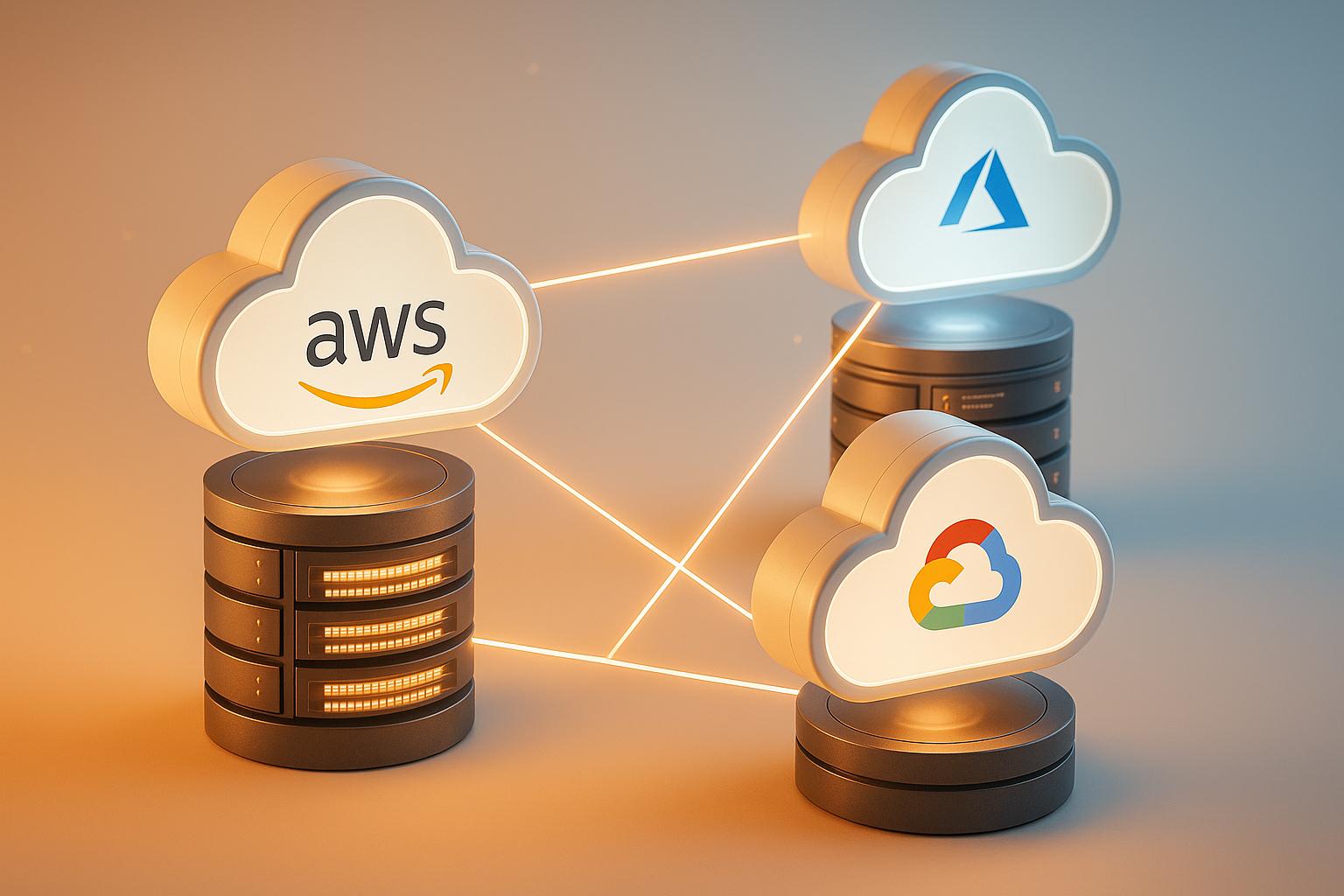Serverless platforms like AWS Lambda, Azure Functions, and Google Cloud Functions dynamically scale resources based on demand, helping businesses cut costs and improve performance. Here's a quick breakdown:
- AWS Lambda: Offers precise scaling with horizontal models, fast cold start times (~100ms–1s), and deep integration with AWS services. Ideal for businesses needing consistent performance and advanced control.
- Azure Functions: Strong choice for organisations using Microsoft tools. Supports hybrid setups, though cold starts can be slower (up to 5 seconds).
- Google Cloud Functions: Focuses on simplicity, with fast client-side latency (~70ms) and good AI/ML integration. Best for quick deployments.
Quick Comparison
| Feature | AWS Lambda | Azure Functions | Google Cloud Functions |
|---|---|---|---|
| Cold Start Latency | ~100ms–1s | ~300ms–5s | ~200ms–1.5s |
| Scaling Mechanism | Concurrent requests | Event-driven | Event-driven |
| Cost (per 1M requests) | £0.20 | £0.20 | £0.40 |
| Free Tier | 1M requests, 400K GB-s | 1M requests, 400K GB-s | 2M requests |
| Integration | AWS ecosystem | Microsoft tools | Google AI & ML |
Each platform serves different needs. AWS is best for stable, large-scale applications. Azure suits hybrid and compliance-focused setups. Google Cloud is great for simplicity and fast deployment. Choose based on your workload, budget, and existing tools.
Cloud Provider Comparisons: AWS vs Azure vs GCP - Serverless
How Each Platform Handles Scaling
Each cloud provider approaches scaling differently, tailoring their mechanisms to adjust resources based on demand.
AWS Lambda Scaling
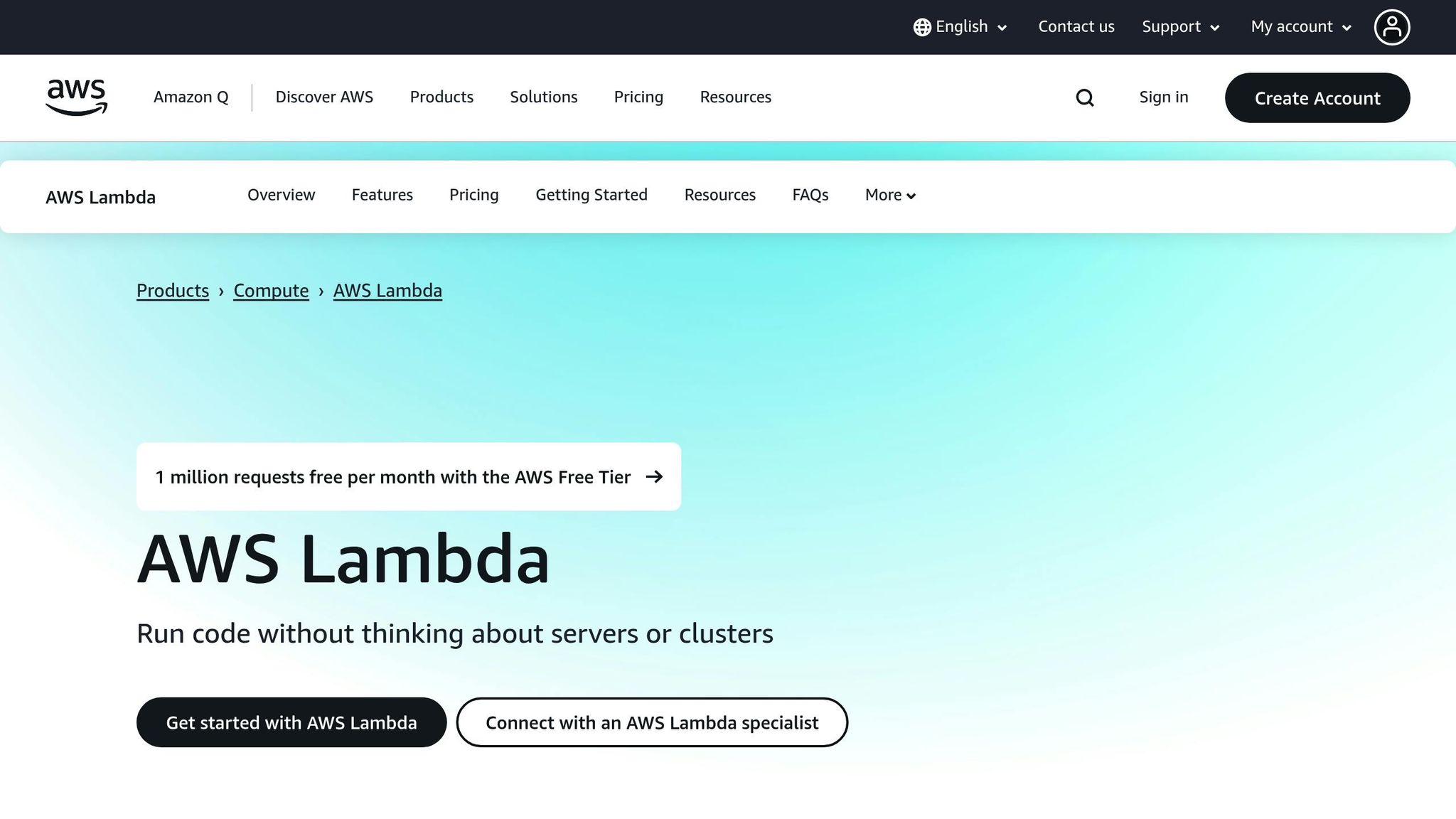
AWS Lambda relies on a horizontal scaling model, where it spins up separate execution environments for each concurrent request. As traffic surges, Lambda automatically provisions new instances, with each instance handling just one request at a time [1].
By default, Lambda operates under a concurrency limit of 1,000 per region for all functions combined [1]. Impressively, it can scale by adding 1,000 instances every 10 seconds, accommodating up to 10,000 requests per second [4].
For users with critical performance needs, AWS offers reserved concurrency, allowing you to allocate a fixed portion of your concurrency limit to specific functions. This ensures those functions can always scale as needed [1]. Additionally, provisioned concurrency keeps environments ready to process requests, eliminating cold starts [1].
Azure Functions Scaling
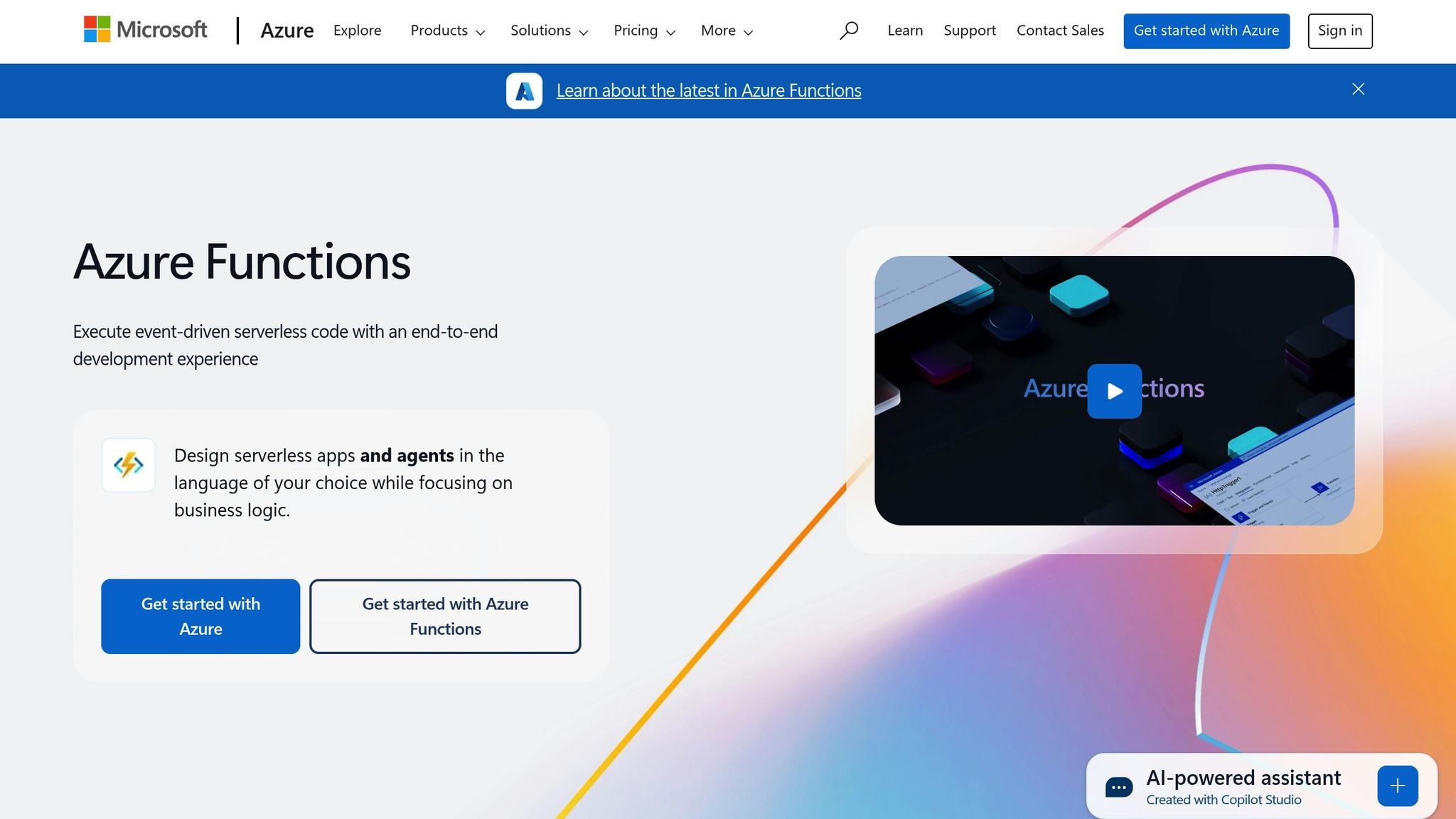
Azure Functions takes an event-driven approach to scaling. Its scale controller continuously monitors event rates and uses tailored algorithms depending on the trigger type to adjust instances [5].
The scaling behaviour depends heavily on the hosting plan you select. The Consumption plan automatically scales based on demand but caps resources at 1.5 GB of memory and one CPU per instance [5]. The Premium plan and Flex Consumption plan offer pre-warmed and always-ready instances to eliminate delays caused by cold starts [2].
Azure's Flex plan also enforces a regional subscription quota, which limits the total memory usage across all instances in a region [2]. For Premium plans in some regions, Linux applications can scale up to 100 instances, while the Consumption plan limits Linux apps to a maximum of 500 new instances per subscription per hour during scaling events [2].
Google Cloud Functions Scaling
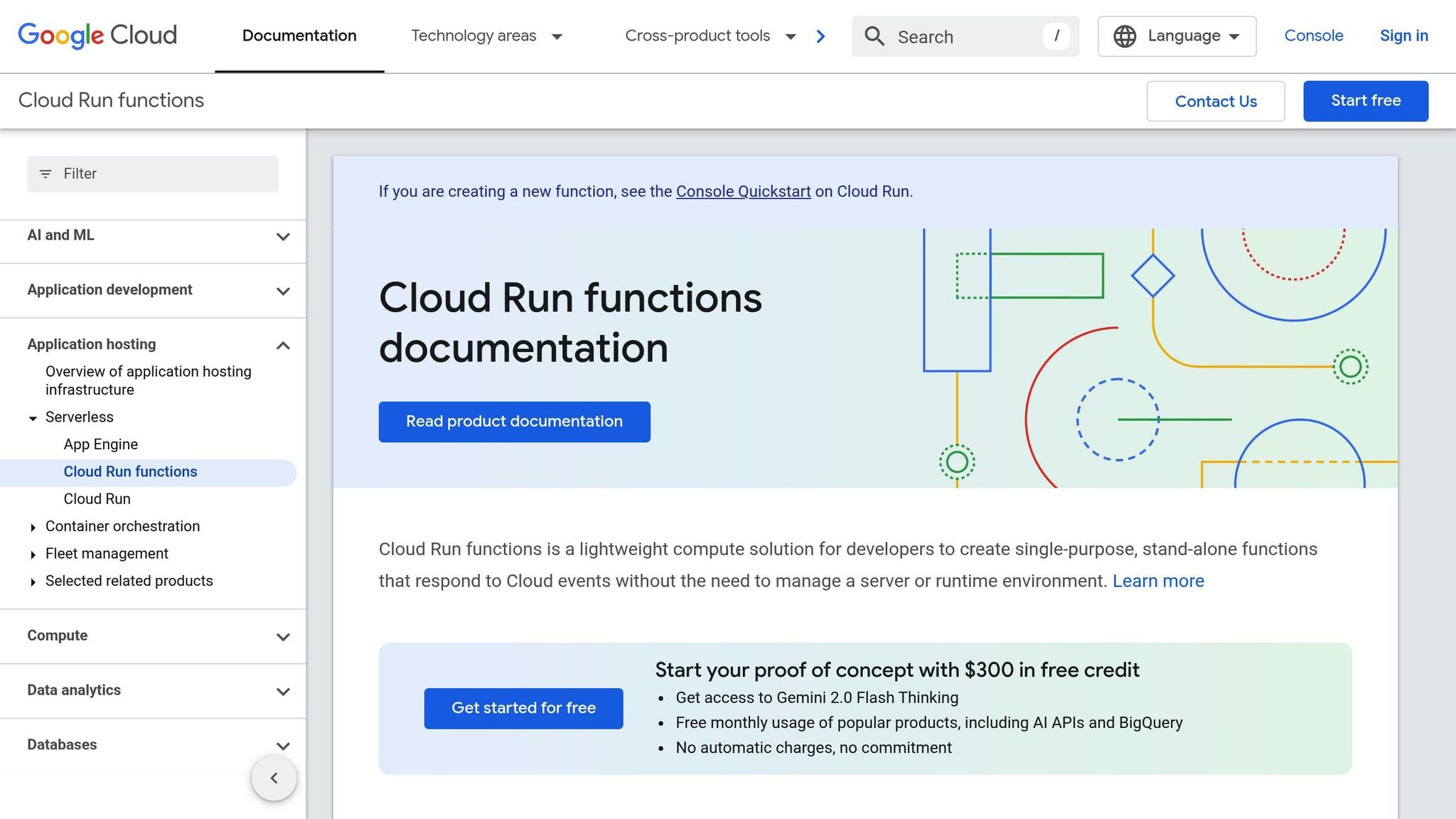
Google Cloud Functions also relies on an event-driven scaling model, automatically adjusting resources based on incoming request rates [6]. The platform creates multiple instances to handle high message volumes concurrently, focusing on simplicity and efficiency.
A standout feature is the max instances
setting, which lets you cap the number of concurrent instances. This is particularly helpful for managing connection limits to databases or APIs, ensuring downstream services aren’t overwhelmed [3].
Google Cloud Functions integrates seamlessly with tools like Cloud Pub/Sub for event triggers [3]. The platform simplifies instance management, allowing developers to focus on building applications without worrying about infrastructure complexity.
Scaling Features Comparison
| Feature | AWS Lambda | Azure Functions | Google Cloud Functions |
|---|---|---|---|
| Scaling Triggers/Mechanisms | Concurrent requests | Incoming events | Incoming requests |
| Default Concurrency Limits | 1,000 per region | Plan-dependent | Project and region dependent |
| Scaling Rate | 1,000 instances per 10 seconds | Variable by trigger type | Based on incoming request rate |
| Cold Start Management | Provisioned concurrency, SnapStart | Pre-warmed instances (Premium), Always-ready instances (Flex) | Minimum instances setting |
| Maximum Instances | Account-level quotas | Up to 100 (Premium, some regions) | Configurable max instances |
| Memory Limits | Up to 10,240 MB | 1.5 GB (Consumption) | Up to 8 GB |
Each platform caters to different needs. AWS Lambda offers detailed control over scaling, Azure Functions provides adaptable hosting plans for diverse scenarios, and Google Cloud Functions prioritises simplicity and ease of use.
Performance and Response Times
When it comes to application efficiency and user experience, performance and response times are just as important as scalability. The performance differences across serverless platforms can significantly influence how an application runs. Factors like cold start latency, overall response times, and network performance play a direct role in shaping user satisfaction and business outcomes.
Response Time Comparisons
Cold start performance is one area where serverless platforms differ noticeably. AWS Lambda stands out with cold start times typically under one second, ranging from 100 milliseconds to 1 second depending on the programming language and package size [7]. Google Cloud Functions usually sees cold starts between 200 milliseconds and 1.5 seconds, while Azure Functions can experience delays of up to 5 seconds, depending on the language and hosting plan [9].
The frequency of cold starts also varies. AWS Lambda maintains a longer interval between cold starts - around 120 minutes - allowing functions to stay warm longer. In contrast, Azure Functions may encounter cold starts every 40 minutes, which can lead to more frequent disruptions [10].
For UK-based data centres like Azure's UK South, AWS's eu-west-2, and Google Cloud's europe-west-2, latencies hover around 150–180 milliseconds [7]. These differences in response times can directly affect business outcomes, especially in time-sensitive industries.
Impact on UK Businesses
For businesses in the UK, performance metrics like these aren't just technical details - they directly influence revenue and operational efficiency. Studies show that even a 100-millisecond slowdown can cost a business unit generating £80 million annually the equivalent of an 88-hour outage [12]. Interestingly, slow response times can cause nearly double the financial loss compared to complete outages [12].
E-commerce businesses are particularly sensitive to performance. For instance, a website that loads in 1 second can achieve conversion rates three times higher than one that takes 5 seconds to load, and five times higher than a site with a 10-second load time [12]. For UK retailers competing in a fast-moving online market, choosing the right serverless platform could make or break their success.
SaaS companies face similar challenges, as 70–85% of their revenue comes from renewals. Poor performance not only impacts immediate sales but also damages long-term customer relationships. In fact, 90% of respondents in a survey agreed that poor SaaS performance significantly disrupts business operations [12].
For real-time applications like trading platforms, live chat systems, or IoT processing, sub-second response times are essential. AWS Lambda's predictable performance and Google Cloud Functions' fast client-side latency are strong assets here, whereas Azure Functions' higher variability could pose challenges [10].
The rise of remote working has further underscored the importance of reliable performance. Gartner predicts that by 2024, 40% of enterprises will expand their Digital Experience Monitoring to include remote workers, up from less than 1% in 2020 [12].
Performance Metrics Comparison
The table below highlights key performance metrics across major platforms, showing how these differences can impact overall system performance.
| Metric | AWS Lambda | Azure Functions | Google Cloud Functions |
|---|---|---|---|
| Cold Start Latency | 100 ms–1 s | 300 ms–5 s | 200 ms–1.5 s |
| Time Between Cold Starts | ~120 minutes | ~40 minutes | Variable |
| API Response Latency | ~100 ms | ~90 ms | ~70 ms |
| Static Content Delivery | ~60 ms | ~50 ms | ~40 ms |
| Function Latency Stability | Most stable | High variance | Moderate |
| Client-Side Performance | Consistent | Variable | Fastest |
AWS Lambda offers an optional provisioned concurrency feature that eliminates cold starts entirely, though it comes with an added cost. Azure counters this with its Premium Plan, which can cut cold start delays by up to 70% using pre-warmed instances [7]. Google Cloud Functions, on the other hand, focuses on ease of deployment over cold start optimisations.
Ultimately, the right choice depends on your specific needs. AWS Lambda delivers the most consistent performance, making it ideal for applications requiring stable latency. Google Cloud Functions excels in client-side performance, making it a strong option for latency-sensitive tasks. Azure Functions, with its Premium Plan, can be a good fit for businesses looking to address cold start issues without sacrificing flexibility. For UK businesses - where 86% of global IT decision-makers agree that low-latency applications are a competitive advantage [12] - choosing the right platform is crucial for staying ahead.
Cost Impact of Different Scaling Models
Understanding serverless pricing is crucial for businesses in the UK. Each platform operates on a pay-as-you-go model, and the differences in pricing can significantly affect operating costs. Building on earlier discussions about scaling, these pricing models are a key factor when evaluating vendors. Let’s break down these cost structures.
AWS Lambda Costs
AWS Lambda uses a straightforward pay-per-use model, charging based on the number of requests and the duration of code execution. Execution time is measured from the moment code starts running until it finishes, rounded up to the nearest millisecond. Costs depend on the memory allocated, which can range from 128 MB to 10,240 MB.
For x86 architecture, AWS charges £0.0000166667 per GB-second (for the first 6 billion GB-seconds each month) and £0.20 per 1 million requests. For the Arm architecture, the cost is slightly lower at £0.0000133334 per GB-second, with the same request pricing.
Here’s an example: if you run 3 million requests with an average runtime of 120 milliseconds and allocate 1,536 MB of memory, the estimated monthly cost is around £2.73. For a more demanding use case - like processing 7,440,000 telemetry messages per month with 1 GB of memory and a 2-second execution time - the cost could climb to approximately £249.49. AWS also offers Provisioned Concurrency to eliminate cold starts, which ensures more predictable performance but comes with additional charges. [13][8]
Azure Functions Costs
Azure Functions offers three distinct pricing plans:
- Consumption Plan: Charges £0.000016 per GB-second for execution time and £0.20 per million executions.
- Premium Plan: Costs are calculated per second for vCPU and memory usage, priced at £126.29 per vCPU per month and £8.979 per GB per month. This plan requires at least one pre-warmed instance to reduce cold starts and ensure consistent performance.
- Flex Consumption Plan: Combines
On Demand
andAlways Ready
modes. UnderOn Demand
, execution costs are £0.000026 per GB-second and £0.40 per million executions. TheAlways Ready
mode includes a baseline charge of £0.000004 per GB-second, with additional execution costs of £0.000016 per GB-second and the same execution fee of £0.40 per million executions. [14]
Google Cloud Functions Costs
Google Cloud Functions now aligns its pricing with Cloud Run, offering a unified serverless model. Previously, it charged £0.40 per 1 million requests and £0.0000125 per GB-second. Unlike AWS Lambda and Azure Functions, which bill execution time to the nearest millisecond, Google rounds up in 100-millisecond increments. While this approach may be less efficient for very short functions, it provides predictable costs for longer-running processes. [8]
Cost Models Comparison
Here’s a quick comparison of the key pricing features across the three platforms:
| Feature | AWS Lambda | Azure Functions | Google Cloud Functions |
|---|---|---|---|
| Request Pricing | £0.20 per 1M requests | £0.20 per 1M executions (Consumption) | £0.40 per 1M requests |
| Duration Pricing | £0.0000166667/GB-s (x86) | £0.000016/GB-s (Consumption) | £0.0000125/GB-s |
| Free Tier Requests | 1 million/month | 1 million/month | 2 million/month |
| Free Tier Compute | 400,000 GB-seconds | 400,000 GB-seconds | Varies |
| Billing Increment | 1 ms | 1 ms | 100 ms |
| Architecture | x86, Arm | Standard | Standard |
| Premium Options | Provisioned Concurrency | Premium Plan | N/A |
For UK businesses, the choice of platform often depends on workload patterns and the need for consistent performance. AWS Lambda and Azure Functions have similar pricing for basic usage, while Google Cloud Functions offers a more generous free tier but higher request costs.
To keep expenses manageable, businesses can focus on optimising code to reduce execution time and memory usage. Choosing the right pricing plan - such as a Consumption Plan for occasional workloads or a Premium Plan for steady, predictable performance - can make a big difference. Additionally, monitoring data transfer costs, keeping resources within the same cloud region, and breaking down complex tasks into smaller, more efficient functions can help improve cost predictability. These cost-saving measures align well with the performance considerations discussed previously, creating a well-rounded strategy. [8][15]
Need help optimizing your cloud costs?
Get expert advice on how to reduce your cloud expenses without sacrificing performance.
Platform Integration and Management
Selecting the right serverless platform isn’t just about ticking off a list of features - it’s about how well the platform meshes with your current systems and supports your development processes. For businesses in the UK, this level of integration can determine whether a digital transformation is seamless or fraught with operational hurdles.
Ecosystem Integration
Cloud providers have built ecosystems around their serverless platforms, but their approaches to integration vary.
AWS Lambda integrates deeply with Amazon’s vast service portfolio, offering effortless connections to other AWS services. This
code-first
approach gives developers precise control over scaling and performance, making it a solid choice for businesses already rooted in AWS tools.Azure Functions combines configuration and code to fit neatly into Microsoft’s ecosystem. For UK organisations already using Microsoft 365 or Dynamics 365, this means smoother workflows and consistency across operations. Its standout feature is its ability to bridge on-premises systems with the cloud, which is especially useful for companies relying on existing Microsoft infrastructure.
Google Cloud Functions focuses on simplicity with an HTTP-native design, making deployment quick and straightforward. It’s also a gateway to Google’s AI and machine learning services. While Google’s ecosystem isn’t as expansive as AWS or Azure, it shines in areas like data analytics and artificial intelligence.
The choice often comes down to your current tech stack. For example, AWS CloudFormation helped Simple automate processes that used to take months, freeing up time to focus on customer service instead of IT management [17]. Similarly, The Toronto Star cut deployment times from three hours to just 20 minutes using AWS OpsWorks, proving how effective integration can reduce costs and boost productivity [17]. These capabilities lay the groundwork for streamlined DevOps automation, which we’ll explore next.
DevOps and Automation
Serverless platforms today are built with DevOps in mind, offering tools that simplify automation and enhance workflows. Each provider brings something unique to the table:
- AWS offers mature tools like CodePipeline and CloudFormation for cloud-native automation.
- Azure excels in hybrid environments with Azure Automation, making cloud management easier and more secure.
- Google Cloud leverages AI for threat detection and provides straightforward CI/CD pipelines through Google Cloud Build.
The benefits of effective DevOps integration are hard to ignore. Research shows that teams using internal developer platforms see a 10% boost in overall performance and an 8% increase in individual productivity [16]. AI adoption also plays a role, with a 25% increase in AI usage linked to improvements in documentation quality (7.5%), code quality (3.4%), and code review speed (3.1%) [16].
For monitoring, each platform offers robust options:
- AWS CloudWatch integrates seamlessly with AWS services.
- Azure Monitor provides a unified view of application and infrastructure health.
- Google Cloud Monitoring supports hybrid and multi-cloud setups with automatic metric collection [19].
Beyond automation, UK businesses must also consider regulatory requirements and hybrid cloud solutions.
Regulatory and Hybrid Cloud Suitability
UK organisations face strict regulations, particularly around data residency and GDPR compliance. Each platform offers tools to address these needs:
- Azure Arc allows management of resources across on-premises, Azure, and other cloud environments, with strong monitoring and policy enforcement capabilities.
- Google Anthos delivers multi-cloud Kubernetes management across GCP, AWS, and on-premises systems.
- AWS supports compliance through services like Trusted Advisor and Technical Account Managers, though its hybrid capabilities are less extensive than Azure or Google.
Real-world examples highlight these capabilities. The NHS leveraged Azure for secure cloud transformation while meeting GDPR and NHS data residency standards [11]. The Driver and Vehicle Standards Agency used both AWS and Azure for efficient data sharing, while the UKHSA’s Halo platform, developed by BJSS, spanned AWS, Azure, GCP, and on-premises systems, onboarding over 18,000 users [18].
| Feature/Service | AWS | Azure | Google Cloud |
|---|---|---|---|
| Hybrid Solution | AWS Outposts, Direct Connect | Azure Arc, Azure Stack | Google Anthos |
| Multi-Cloud Support | Partial via EKS Anywhere | Native via Arc & Terraform | Strong with Anthos |
| Container Management | EKS, ECS | AKS, Azure Container Apps | GKE Autopilot, Anthos Mesh |
For UK businesses, the best platform depends on your existing systems, compliance needs, and long-term goals. Companies already invested in Microsoft tools might find Azure’s integration hard to beat, while those relying on AWS services may lean towards Lambda. Organisations prioritising multi-cloud flexibility or advanced AI capabilities might see Google Cloud Functions as the better fit.
Platform Recommendations and Next Steps
Choosing the right serverless platform is a critical decision that depends on your business's specific needs, existing infrastructure, and long-term goals. Each platform offers distinct advantages, so it's all about finding the one that delivers the right mix of flexibility, performance, and cost-effectiveness for your organisation.
Which Platform for Which Use Case
AWS Lambda is an excellent choice for businesses already operating within the AWS ecosystem. Its code-first
approach and deep integration with AWS services make it ideal for enterprise-scale applications that demand precise scalability.
In 7 years of running production workloads on AWS Lambda, across Node, Python, Java, and custom runtimes, I can't think of one time where our client has regretted the decision. The operational burden is dramatically lower and - after an initial learning curve - developer and DevOps productivity much higher.
– Andy Warzon, CTO, Trek10 [20]
Azure Functions fits perfectly for organisations heavily invested in Microsoft technologies. It's particularly valuable for businesses needing integrated workflows, hybrid cloud support, and regulatory compliance. For UK enterprises, this alignment with existing Microsoft tools ensures your serverless strategy supports both operational and compliance requirements.
Google Cloud Functions is the go-to platform for teams prioritising simplicity and quick deployment. It’s a favourite among businesses seeking minimal configuration and fast execution. Additionally, Google Cloud is a leader in container-based serverless solutions, with 66% of serverless organisations adopting container-based workloads [20].
When deciding, remember that pricing across platforms is competitive. Instead of focusing solely on base costs, consider your specific usage patterns and existing cloud commitments. For instance, low-latency applications benefit from AWS Lambda's advanced scaling, while hybrid setups often align better with Azure Functions' seamless on-premises integration. If you're unsure which platform suits your needs, consulting with experts can simplify the decision-making process.
Hokstad Consulting's Expertise
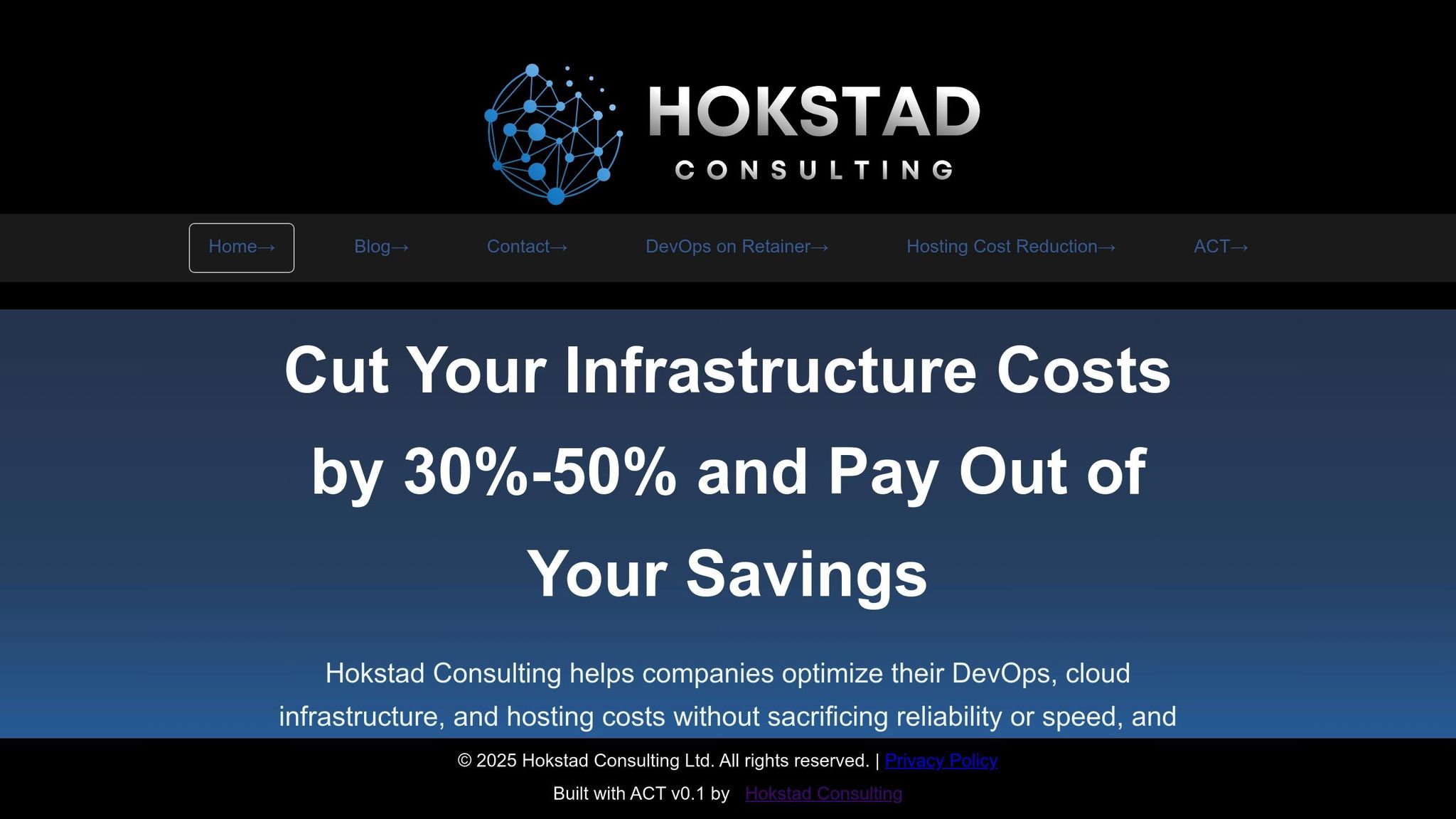
Selecting and optimising the right platform often requires professional insight. Hokstad Consulting specialises in cloud cost management and DevOps transformation, helping UK businesses cut cloud expenses by 30–50% while improving deployment efficiency.
Their approach includes assessing your infrastructure, compliance requirements, and team capabilities to recommend the most suitable serverless platform. Whether you're migrating from traditional hosting, refining current serverless operations, or implementing hybrid solutions, Hokstad Consulting's expertise spans AWS, Azure, and Google Cloud.
Their No Savings, No Fee
model guarantees their services align with your cost optimisation goals. Plus, their ongoing support ensures your serverless infrastructure remains secure and efficient as it scales. For UK organisations navigating GDPR compliance, data residency rules, and multi-cloud strategies, their tailored solutions provide a reliable way to maximise serverless benefits while reducing operational complexity.
FAQs
What should I consider when choosing between AWS Lambda, Azure Functions, and Google Cloud Functions for serverless scalability?
When looking at AWS Lambda, Azure Functions, and Google Cloud Functions for serverless scalability, several factors come into play - scaling capabilities, cost considerations, and how well they integrate with other services.
AWS Lambda stands out with its powerful automatic scaling and support for a broad range of runtimes. This makes it a strong choice for handling workloads that can change dramatically in demand. On the other hand, Azure Functions works seamlessly within Microsoft's ecosystem, offering flexible scaling options that are especially appealing for organisations already invested in Azure services. Meanwhile, Google Cloud Functions emphasises simplicity, event-driven scaling, and affordability, with excellent integration into Google's suite of data and AI tools.
The best option for you will largely depend on what your workload demands, the cloud infrastructure you already use, and how much you're looking to spend.
How do cold start delays in AWS Lambda, Azure Functions, and Google Cloud Functions affect application performance?
Cold start delays can noticeably affect how well an application performs, adding latency when serverless functions are invoked for the first time. For example, AWS Lambda often sees cold start times exceeding 100 milliseconds, with more complex functions taking even longer. Azure Functions might face delays ranging from a few hundred milliseconds to several seconds, especially in scenarios with high demand. Meanwhile, Google Cloud Functions may even surpass API timeouts during cold starts, particularly if dependencies are large or poorly optimised.
These delays can hurt user experience and responsiveness, so it's important to adopt strategies to reduce their impact. This might include shrinking dependency sizes or leveraging provisioned concurrency to keep performance consistent.
How can UK businesses reduce costs when using serverless platforms like AWS, Azure, or Google Cloud?
Cost-Saving Strategies for Serverless Platforms in the UK
For UK businesses using serverless platforms like AWS, Azure, or Google Cloud, there are smart ways to manage costs without sacrificing efficiency. A key step is to fine-tune resource allocation, ensuring you're only paying for what you actually use. Features like autoscaling can be a game-changer, automatically adjusting resources to meet demand. Plus, opting for reserved or spot instances can lead to substantial savings by securing lower rates for predictable workloads.
Built-in cost management tools are another valuable ally. Platforms offer solutions like AWS Cost Explorer, Azure Cost Management, and Google Cloud's Cost Management to help you track spending and identify areas for improvement. Regularly reviewing your usage and automating resource allocation can prevent waste and keep costs in check over time.
If you're looking for tailored advice, consulting firms like Hokstad Consulting can provide expert guidance. They specialise in helping UK businesses trim cloud expenses and optimise their serverless infrastructure for maximum efficiency.
